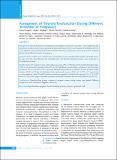Please use this identifier to cite or link to this item:
https://hdl.handle.net/20.500.14356/2285Full metadata record
| DC Field | Value | Language |
|---|---|---|
| dc.contributor.author | Prajapati, Sunita | - |
| dc.contributor.author | Prajapati, Gayatri | - |
| dc.contributor.author | Shrestha, Vikram | - |
| dc.contributor.author | Shrestha, Sujata | - |
| dc.date.accessioned | 2023-07-30T08:08:45Z | - |
| dc.date.available | 2023-07-30T08:08:45Z | - |
| dc.date.issued | 2022 | - |
| dc.identifier.citation | PrajapatiS., PrajapatiG., ShresthaV., & ShresthaS. (2023). Assessment of Thyroid Dysfunction During Different Trimester of Pregnancy. Journal of Nepal Health Research Council, 20(4), 830-833. | en_US |
| dc.identifier.issn | Print ISSN: 1727-5482; Online ISSN: 1999-6217 | - |
| dc.identifier.uri | https://hdl.handle.net/20.500.14356/2285 | - |
| dc.description | Original Article | en_US |
| dc.description.abstract | Abstract Background: Thyroid dysfunction is frequently seen in pregnant women and is associated with complications like miscarriage, gestational hypertension, placental abruption, pre mature delivery and fetal growth retardation and even causes impaired neuropsychological development of fetus. This study is carried out to assess the prevalence of thyroid disorder during different trimester of pregnancy. Methods: Serum samples were collected from 124 pregnant women attending Patan Academy of Health Science for ante natal visit. Free thyroxine free triiodothyronine and thyroid stimulating hormone were performed by chemiluminescent assay. Results: Out of 124 pregnant women, euthyroidism was seen in 79% (n =98) followed by subclinical hypothyroidism (10%, n=13) and primary hypothyroidism (8%, n=10). Subclinical hyperthyroidism and primary hyperthyroidism accounts for 1% (n=1), and 2% (n=2) respectively. Although, thyroid disorder was found to be more prevalent in third trimester (38.4%, n=10) but the distribution in first and second trimester (34.6%, n= 9, 27%, n= 7 respectively) were also significant. Mean fT3 and fT4 level were found to be negatively correlated with trimester (r=-0.19, p=0.027 and r=-0.29, p=0.001 respectively) whereas positive correlation of trimester was seen with TSH (r=0.08, p=0.35). Conclusions: Hypothyroidism is more common in pregnant women visiting tertiary care hospital. Different complication can be minimized if diagnosis is done early. Keywords: Hypothyroidism; pregnant; thyroid stimulating hormone; trimester, gestational week | en_US |
| dc.language.iso | en | en_US |
| dc.publisher | Government of Nepal; Nepal Health Research Council; Ramshah Path, Kathmandu, Nepal | en_US |
| dc.relation.ispartofseries | Oct-Dec, 2022;3712 | - |
| dc.subject | Hypothyroidism | en_US |
| dc.subject | Pregnant | en_US |
| dc.subject | Thyroid stimulating hormone | en_US |
| dc.subject | Trimester | en_US |
| dc.subject | Gestational week | en_US |
| dc.title | Assessment of Thyroid Dysfunction During Different Trimester of Pregnancy | en_US |
| dc.type | Journal Article | en_US |
| Appears in Collections: | Vol 20 No 04 Issue 57 Oct-Dec, 2022 | |
Files in This Item:
| File | Description | Size | Format | |
|---|---|---|---|---|
| 3712-Manuscript-32156-1-10-20230720.pdf | Fulltext. | 230.61 kB | Adobe PDF |  View/Open |
Items in DSpace are protected by copyright, with all rights reserved, unless otherwise indicated.
